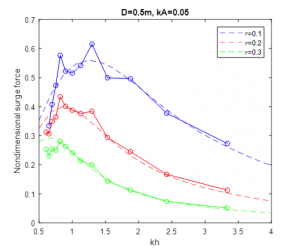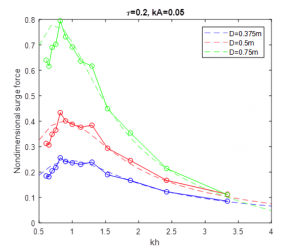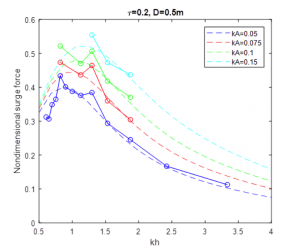Project purpose: To assess the use of porous structures to reduce loads on a floating offshore wind turbine
The tank tests were conducted at Dalian as a cross-border activity within the ResIn project, enabled through a collaborative design effort. The work took place between March and June 2018. The purpose of the tank tests was to validate the numerical models for wave interaction with porous structures, developed as part of WP2. Two sets of tests were conducted in parallel. One set of tests measured the loads on flat porous sheets of various specifications (porosity, hole-spacing, thickness).
The other set of tests measured the loads on porous cylinders both with and without a solid inner cylinder. The graphs below show some comparisons between the experimental results (circles) and the BEM model predictions (dashed lines) for tests with porous cylinders. The plots show the nondimensional surge force against nondimensional wavenumber. The first plot shows results for a cylinder diameter of 0.5m, wave steepness kA=0.05 and porosity τ = 0.1, 0.2 and 0.3. The second plot shows results for constant porosity of τ = 0.2, wave steepness kA=0.05 and three diameters D = 0.375, 0.5 and 0.75m. The third plot shows results for a single cylinder of porosity of τ = 0.2 and diameter D = 5m in waves of steepness between kA = 0.05 and 0.15. The numerical predictions and experimental results show good agreement in all cases.

Comparison between numerical (dashed lines) and experimental (circles) results for surge force on a porous cylinder, for three values of porosity.

Comparison between numerical (dashed lines) and experimental (circles) results for surge force on a porous cylinder, for three values of cylinder diameter.

Comparison between numerical (dashed lines) and experimental (circles) results for surge force on a porous cylinder, for four values of wave steepness.